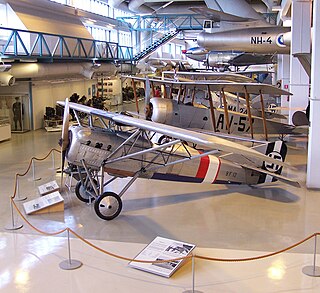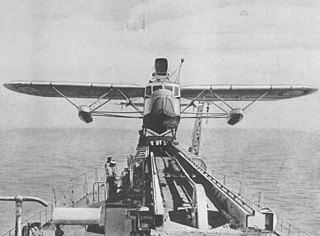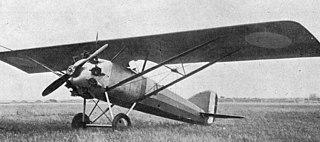
French Naval Aviation is the naval air arm of the French Navy. The long-form official designation is Force maritime de l'aéronautique navale. Born as a fusion of carrier squadrons and the naval patrol air force, the Aéronavale was created in 1912. The force is under the command of a flag officer officially named Admiral of Naval Aviation (ALAVIA) with his headquarters at Toulon naval base. It has a strength of around 6,800 military and civilian personnel. It operates from four airbases in Metropolitan France and several detachments in foreign countries or French overseas territories. Carrier-borne pilots of the French navy do their initial training at Salon-de-Provence Air Base after which they undergo their carrier qualification with the US Navy.

Commandant Teste was a large seaplane tender of the French Navy built before World War II. She was designed to be as large as possible without counting against the Washington Treaty limits. During the Spanish Civil War, she protected neutral merchant shipping and played a limited role during World War II as she spent the early part of the war in North African waters or acting as an aviation transport between France and North Africa. She was slightly damaged during the British bombardment of the French Fleet at Mers-el-Kébir in July 1940. Commandant Teste was scuttled at Toulon when the Germans invaded Vichy France in November 1942, but was refloated after the war and considered for conversion to an escort or training carrier. Neither proposal was accepted and she was sold for scrap in 1950.

The three Duguay-Trouin-class light cruisers were the first major French warships built after World War I. They were excellent steamers and proved successful and seaworthy over a quarter century of service. All three achieved 33 knots on trials and could easily maintain 30 knots in service. Twenty-year-old Duguay-Trouin could still maintain 27.7 knots at her post-war displacement of 10,900 tons. They were fast and economical, although with a limited range. The fate of these three ships after the French surrender illustrates the dichotomy within the French armed forces at the time: one ship was interned, then joined the Free French, another twice resisted Allied bombardment and was destroyed, and the third was disarmed at a French colonial port and subsequently sunk.

The Gourdou-Leseurre GL.2 was a French fighter aircraft which made its maiden flight in 1918.

The Loire 46 was a French single-seater fighter aircraft of the 1930s. A high-winged monoplane designed and built by Loire Aviation, it was purchased by the French Air Force. It was also supplied to the Spanish Republican forces during the Spanish Civil War, but was almost out of service by the outbreak of World War II.

The Loire 130 was a French flying boat that saw service during World War II. It was designed and built by Loire Aviation of St Nazaire.

The Gourdou-Leseurre GL-832 HY was a 1930s French light shipboard reconnaissance floatplane design and built by Gourdou-Leseurre for the French Navy.
The Gourdou-Leseurre GL.50, also known as the Gourdou-Leseurre Type F, was a French fighter prototype of the early 1920s.

The Wibault 7 was a 1920s French monoplane fighter designed and built by Société des Avions Michel Wibault. Variants were operated by the French and Polish military and built under licence for Chile as the Vickers Wibault.

The Villiers II was a French two-seat fighter aircraft of the 1920s intended for operation from the Aircraft carrier Béarn of the French Navy. It was a single-engined tractor biplane with a waterproof hull in the form of a flying boat to allow the aircraft to be safely landed on water in an emergency. Two prototypes and 30 production aircraft were built, the type serving briefly with the French Navy, although never operated from an aircraft carrier.

Avions Amiot was a former French aircraft manufacturer. The company was formed in 1916 by Félix Amiot as the Society of Mechanical Drawing and Construction (SECM).

Zmaj officially named Fabrika aeroplana i hidroaviona Zmaj was a Yugoslav aircraft manufacturer. It was founded in 1927 and it was the third aeronatical factory in Serbia. At the beginning it manufactured aircraft under French license, and in 1932 it started with local planes designed by Jovan Petrović and Dragoljub Šterić. Several types of aircraft were manufactured by Zmaj, among them passenger Spartans for the domestic airliner Aeroput. Zmaj workshops manufactured in total 359 aircraft up until 1946, when the factory stopped manufacturing for aviation industry purposes and the company was nationalised and merged with Rogožarski into Ikarus.
The Gourdou-Leseurre GL-820 HY family of four-seat single-engined floatplanes were designed and built in France during the latter half of the 1930s by Gourdou-Leseurre. The GL-820 HY and GL-821 HY 02 were shipborne reconnaissance / obeservation aircraft, while the sole GL-821 HY was built as a torpedo carrier.


















